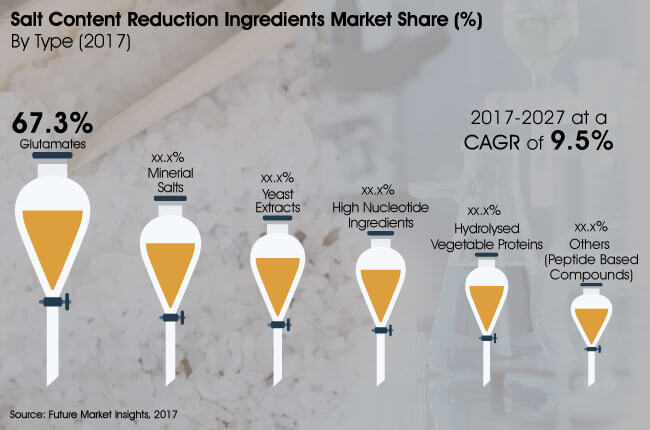International nutrition guidelines recommend that sodium consumption should be less than 5 grams per day. Consumption of reduced salt products makes it feasible to control major health concerns such as kidney stones, stomach cancer, high blood pressure, and osteoporosis. It has been observed that consumers worldwide now prefer products with lower salt content as they are concerned about these diseases. Thus, Future Market Insights has prepared the report ‘Salt Content Reduction Ingredients Market: Global Industry Analysis (2012 – 2016) and Opportunity Assessment (2017 – 2027)’ which estimates that the salt content reduction ingredients market is expected to be worth more than US$ 7 billion by 2027.
Type – Monosodium Glutamates Offer Best of Both Worlds Making them Sought After
Replacing table salt with monosodium glutamates reduces the sodium content by 40% without taste loss as MSG contains approx. 1/3rd the sodium. Glutamates can reduce the salt content in bakery products, sauces, and seasonings while enhancing the savoury umami flavour. Glutamates contribute only 2% of total sodium in the average diet even when MSG is widely used which explains its dominance in the salt content reduction ingredients market. Glutamates are predicted to retain a market share of almost 2/3rd the salt content reduction ingredients market by type at the end of the forecast period.

Application – Meat & Poultry Segment Need Salt Content Reduction Ingredients Most
The meat & poultry segment is on track to account for a quarter of the salt content reduction ingredients market by end 2027 and could gain 60 BPS by then. A number of salt content reduction ingredients such as yeast extracts and potassium chloride are utilized in meat & poultry products. The substitution of sodium chloride with potassium chloride in meat can go a long way in reducing its sodium content. The meat & poultry segment is anticipated to have a value of just under US$ 700 million in 2017 alone, making it an opportunity too large to ignore.
Request a Complete TOC of this Report with figures:
https://www.futuremarketinsights.com/toc/rep-gb-1980
Region – Focus on North America and APEJ Salt Content Reduction Ingredients Market
The North America salt content reduction ingredients market is poised to remain strong, largely due to stringent government policies and regulations pertaining to voluntary sodium reduction in the US. A much higher growth is likely in the APEJ region with a surging demand for processed food to cater to the massive continental populations of both China and India. A massive 140 BPS growth should help APEJ be worth over US$ 1.1 billion in 2027 and record an exponential CAGR of 10.5% for the period.
Salt Content Reduction Ingredients Market Taxonomy
Type
- Yeast Extracts
- Glutamates (Monosodium/Potassium)
- High Nucleotide Ingredients (Disodium Inosinate, Calcium Inosinate, etc.)
- Hydrolysed Vegetable Protein (HVP)
- Mineral Salts (KCl, K2SO4, CaCl2, etc.)
- Others (Peptide Based Compounds, etc.)
Application
- Dairy Products
- Bakery Products
- Fish Derivatives
- Meat and Poultry
- Beverages
- Sauces and Seasonings
- Others (Snacks, etc.)
Region
- North America
- Latin America
- Western Europe
- Eastern Europe
- APEJ
- Japan
- MEA
Competition Dashboard in the Salt Content Reduction Ingredients Market
Some of the companies profiled in the report are Cargill, Koninklijke DSM N.V., E.I. du Pont de Nemours & Co., Advanced Food Systems, Sensient Technologies Corporation, Associated British Foods PLC, Kerry Group, Savoury Systems International, Angel Yeast Co., Smart Salt Inc., Jugbunzlauer Suisse A.G., Ajinomoto Co., Givaudan SA, Archers Daniels Midland Company, Tate & Lyle PLC, Innophos Holdings, and Fufeng Group.
Key Takeaways
Consumers across the globe have shown a greater preference for consuming low salt products because of awareness of the connection between excessive salt intake and cardiovascular and other ailments. The rising prevalence of obesity coupled with doctor’s advice plays a supplementary role and thus, the scope of the salt content reduction ingredients market is extremely bright in the long run.
About Chemicals & Materials division of FMI
The Chemicals & Materials division at FMI offers distinct and pin-point analysis about the chemicals & materials industry. Coverage of the chemicals and materials market extends from commodity, bulk, specialty and petrochemicals to advanced materials, composites, and nanotechnology. The team also puts special emphasis on ‘green alternatives’, recycling and renewable technology developments, and supply-demand trade assessment. Our research studies are widely referred by chemical manufacturers, research institutions, channel partners, and government bodies for developing – ‘The Way Forward’.
